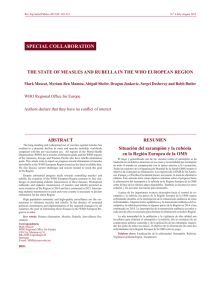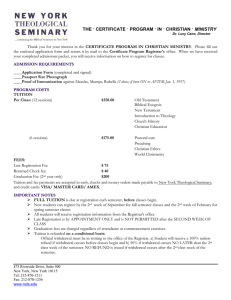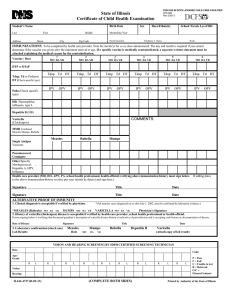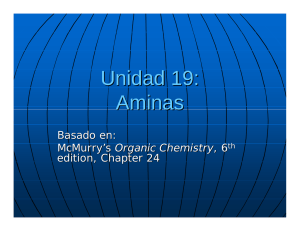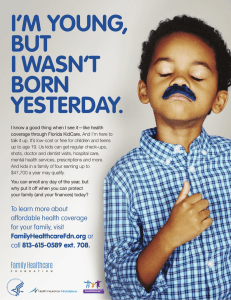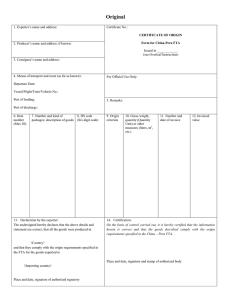verifying the elimination of measles and rubella
Anuncio
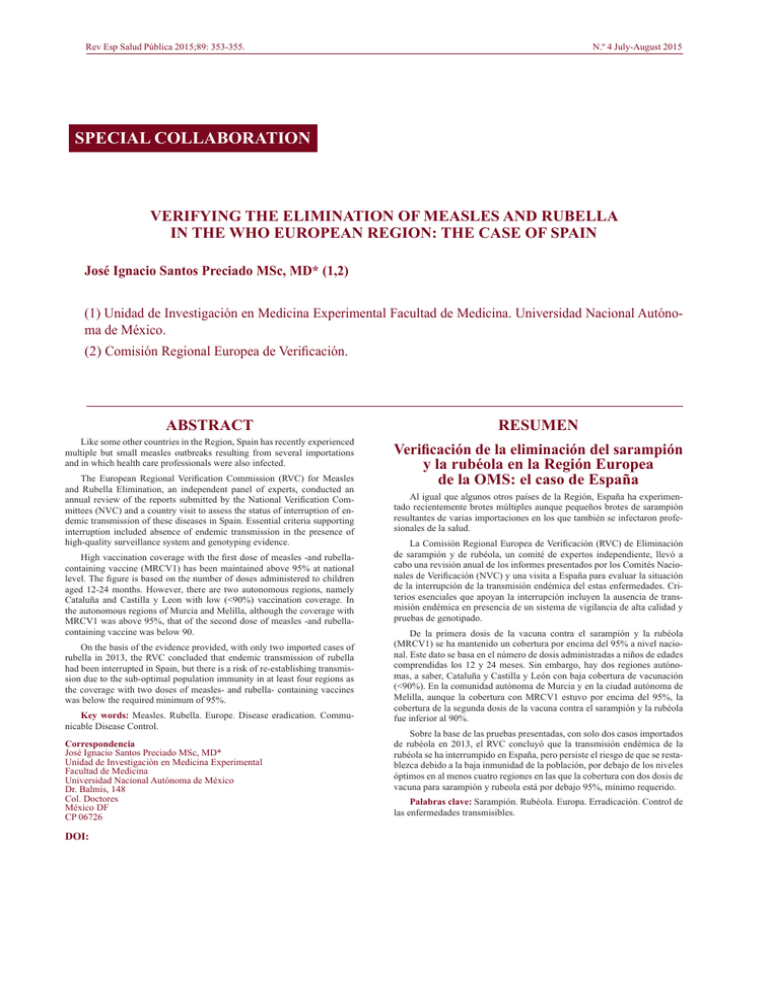
Rev Esp Salud Pública 2015;89: 353-355. N.º 4 July-August 2015 SPECIAL COLLABORATION VERIFYING THE ELIMINATION OF MEASLES AND RUBELLA IN THE WHO EUROPEAN REGION: THE CASE OF SPAIN José Ignacio Santos Preciado MSc, MD* (1,2) (1) Unidad de Investigación en Medicina Experimental Facultad de Medicina. Universidad Nacional Autónoma de México. (2) Comisión Regional Europea de Verificación. ABSTRACT RESUMEN Like some other countries in the Region, Spain has recently experienced multiple but small measles outbreaks resulting from several importations and in which health care professionals were also infected. Verificación de la eliminación del sarampión y la rubéola en la Región Europea de la OMS: el caso de España The European Regional Verification Commission (RVC) for Measles and Rubella Elimination, an independent panel of experts, conducted an annual review of the reports submitted by the National Verification Committees (NVC) and a country visit to assess the status of interruption of endemic transmission of these diseases in Spain. Essential criteria supporting interruption included absence of endemic transmission in the presence of high-quality surveillance system and genotyping evidence. High vaccination coverage with the first dose of measles -and rubellacontaining vaccine (MRCV1) has been maintained above 95% at national level. The figure is based on the number of doses administered to children aged 12-24 months. However, there are two autonomous regions, namely Cataluña and Castilla y Leon with low (<90%) vaccination coverage. In the autonomous regions of Murcia and Melilla, although the coverage with MRCV1 was above 95%, that of the second dose of measles -and rubellacontaining vaccine was below 90. On the basis of the evidence provided, with only two imported cases of rubella in 2013, the RVC concluded that endemic transmission of rubella had been interrupted in Spain, but there is a risk of re-establishing transmission due to the sub-optimal population immunity in at least four regions as the coverage with two doses of measles- and rubella- containing vaccines was below the required minimum of 95%. Key words: Measles. Rubella. Europe. Disease eradication. Communicable Disease Control. Correspondencia José Ignacio Santos Preciado MSc, MD* Unidad de Investigación en Medicina Experimental Facultad de Medicina Universidad Nacional Autónoma de México Dr. Balmis, 148 Col. Doctores México DF CP 06726 DOI: Al igual que algunos otros países de la Región, España ha experimentado recientemente brotes múltiples aunque pequeños brotes de sarampión resultantes de varias importaciones en los que también se infectaron profesionales de la salud. La Comisión Regional Europea de Verificación (RVC) de Eliminación de sarampión y de rubéola, un comité de expertos independiente, llevó a cabo una revisión anual de los informes presentados por los Comités Nacionales de Verificación (NVC) y una visita a España para evaluar la situación de la interrupción de la transmisión endémica del estas enfermedades. Criterios esenciales que apoyan la interrupción incluyen la ausencia de transmisión endémica en presencia de un sistema de vigilancia de alta calidad y pruebas de genotipado. De la primera dosis de la vacuna contra el sarampión y la rubéola (MRCV1) se ha mantenido un cobertura por encima del 95% a nivel nacional. Este dato se basa en el número de dosis administradas a niños de edades comprendidas los 12 y 24 meses. Sin embargo, hay dos regiones autónomas, a saber, Cataluña y Castilla y León con baja cobertura de vacunación (<90%). En la comunidad autónoma de Murcia y en la ciudad autónoma de Melilla, aunque la cobertura con MRCV1 estuvo por encima del 95%, la cobertura de la segunda dosis de la vacuna contra el sarampión y la rubéola fue inferior al 90%. Sobre la base de las pruebas presentadas, con solo dos casos importados de rubéola en 2013, el RVC concluyó que la transmisión endémica de la rubéola se ha interrumpido en España, pero persiste el riesgo de que se restablezca debido a la baja inmunidad de la población, por debajo de los niveles óptimos en al menos cuatro regiones en las que la cobertura con dos dosis de vacuna para sarampión y rubeola está por debajo 95%, mínimo requerido. Palabras clave: Sarampión. Rubéola. Europa. Erradicación. Control de las enfermedades transmisibles. José Ignacio Santos Preciado. THE VERIFICATION PROCESS At the sixtieth session of the WHO Regional Committee for Europe (2010) the ministries of health of all Member States endorsed resolution EUR/RC60/R12, renewing their commitment to measles and rubella elimination and prevention of congenital rubella syndrome in the WHO European Region by 2015.1 In 2012, the World Health Organization Regional Office for Europe established the European Regional Verification Commission (RVC) to verify the elimination of measles and rubella at the Regional level. The RVC is an independent expert body comprising of public health experts, including epidemiologists, clinicians and virologists. It currently includes a chairperson, a vice-chairperson and six members, all of whom are independent of the managerial and operational aspects of elimination activities. The RVC’s mission is to assess the status of interruption of endemic transmission of measles and rubella based on documentation submitted through the National Verification Committee (NVC) of each Member State in line with set procedures.2 The NVCs are requested to report on achieved progress in measles and rubella elimination through an approved standard format of annual national status updates. These updates include information on measles and rubella epidemiology, virologic surveillance supported by molecular epidemiology, the analysis of population immunity and immunization programme performance and the quality of surveillance. For each Member State that submits adequate documentation for assessment by the RVC a conclusion on the status of interruption of measles and rubella is reached. To facilitate this process an algorithm is used based on the criteria of absence of endemic cases in the presence of high-quality surveillance and demonstration of high population 354 immunity. The concluding statement by the RVC may be any of the following: interrupted transmission, interrupted transmission but at risk for re-establishment of transmission, endemic transmission or inconclusive. The RVC works in close collaboration with the WHO Regional Office for Europe, which also serves as its secretariat, and reports to the WHO Regional Director for Europe. The review and evaluation of annual national updates will continue for at least three years after the RVC confirms that, according to established criteria, endemic measles and rubella transmission have been interrupted in all Member States of the Region. Only then can Regional elimination be declared. Conclusions of the Regional Verification Commission for the Region At the third meeting of the RVC held in November 2014 in Denmark, the RVC concluded that for 2013, measles and rubella endemic transmission had been interrupted in 22 and 23 countries, respectively.3 However, nine of these countries had immunity gaps in the population and were thereby at risk of re-establishing endemic transmission. The elimination status of some countries (nine for measles, 12 for rubella) could not be verified due to poor-quality, inconsistent, or incomplete data. Additionally, assessment of laboratory surveillance showed lack of ability in many countries to document virus transmission pathways. Nine countries could not be assessed: six countries did not submit reports and three countries’ reports were deemed inadequate for assessment. The status of measles and rubella elimination in the Region was similar to that in 2012, with regards to the number of countries with interrupted endemic transmission and ability to document virus transmission pathways. However, the overall quality and timeliness of reports had improved. Rev Esp Salud Pública 2015. Vol. 89, N.º 4 VERIFYING THE ELIMINATION OF MEASLES AND RUBELLA IN THE WHO EUROPEAN REGION: THE CASE OF SPAIN MAIN RESULTS OF THE SPANISH NATIONAL ANNUAL UPDATE FOR 2013 Conclusions of the Regional Verification Commission for Spain Surveillance and performance indicators The RVC commended Spain on the decline in the number of reported measles cases but required more information on measles surveillance before any conclusions on the status of measles elimination could be reached. The rate of discarded cases per 100,000 population for measles was 0.18 and for rubella 0.03, respectively. This is below the minimum of 2 cases per 100,000 population, reflecting a low sensitivity of the surveillance system for both diseases. The timeliness of investigation for rubella, was 64.7%, which is also below the required minimum of 80%. The timeliness of notification was also sub-optimal (<80%) with 42.8% for measles and 23.5% for rubella, respectively. The country´s case-based surveillance system for measles and rubella surveillance met most of the remainig performance indicators. The rate of laboratory investigation of cases was above the required mimimum of 80% with 92.2% for measles and 94.1% for rubella. The percentage of cases with documented origin of infection was above the required minimum of 80% with 96.2% for measles cases and for both of the rubella cases. Molecular epidemiologic studies were able to provide evidence for the circulation of measles virus genotypes D8 and B3, likely imported from neighboring countries. Immunization and population immunity High vaccination coverage with the first dose of measles- and rubella-containing vaccine (MRCV1) has been maintained above 95% at national level. The figure is based on the number of doses administered to children aged 12- 24 months. However, there are two autonomous regions, namely Cataluña and Casilla y Leon with low (< 90%) vaccination coverage. In the autonomous regions of Murcia and Melilla althuogh the coverage with MRCV1 was above 95%, that of the second dose of measles- and rubella-containing vaccine was below 90%. Rev Esp Salud Pública 2015. Vol. 89, N.º 4 On the basis of the evidence provided, with only two imported cases of rubella in 2013, the RVC concluded that endemic transmission of rubella had been interrupted, but there is a risk of re-establishing transmission due to the sub-optimal population immunity in at least four regions as the coverage with two doses of measles- and rubella- containing vaccines was below the required minimum of 95%. BIBLIOGRAPHY 1. World Health Organization. European Regional Office, Copenhagen, Denmark. Renewed commitment to elimination of measles and rubella and prevention of congenital rubella syndrome by 2015 and Sustained support for polio-free status in the WHO European Region. 60th Session of the Regional Committee for Europe. Moscow: WHO; 2010. 13-16 September, 2010. Available at: www. euro.who.int/__data/assets/pdf_file/0016/122236/RC60_ eRes12.pdf. (last accessed 9 August 2015). 2. World Health Organization Regional Office for Europe. Eliminating measles and rubella: Framework for the verification process in the WHO European Region. Copenhagen: WHO Regional Office for Europe; año. [cited 10 August 2015]. Available at: www.euro.who. int/__data/assets/pdf_file/0009/247356/Eliminatingmeasles-and-rubella-Framework-for-the-verificationprocess-in-the-WHO-European-Region.pdf?ua=1 3. World Health Organization Regional Office for Europe. Third meeting of the European Regional Verification Commission for Measles and Rubella Elimination. Copenhagen: WHO; 10-12 November 2014. Available at: www.euro.who.int/__data/assets/pdf_ file/0011/275519/3rd-Meeting-European-RVC-MeaslesRubella-Elimination.pdf?ua=1 (last accessed 14 August 2015). 355
